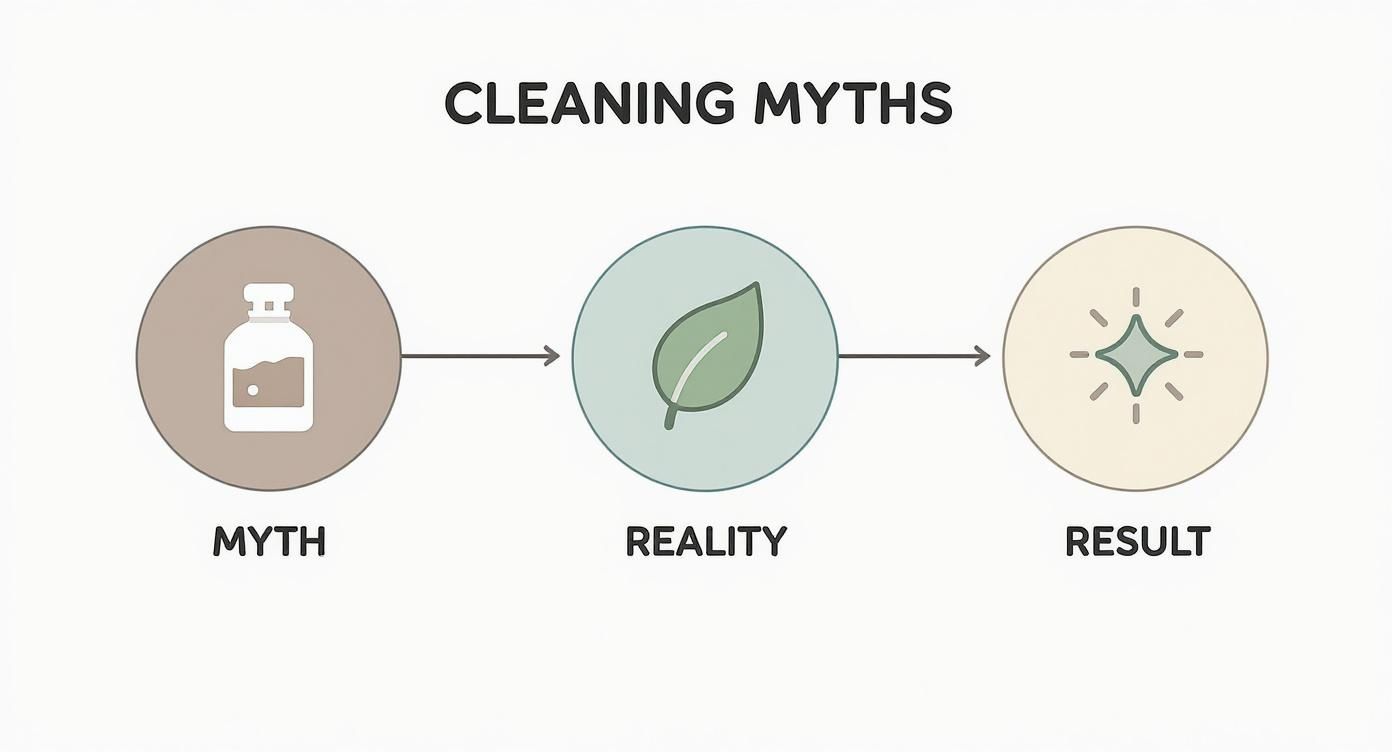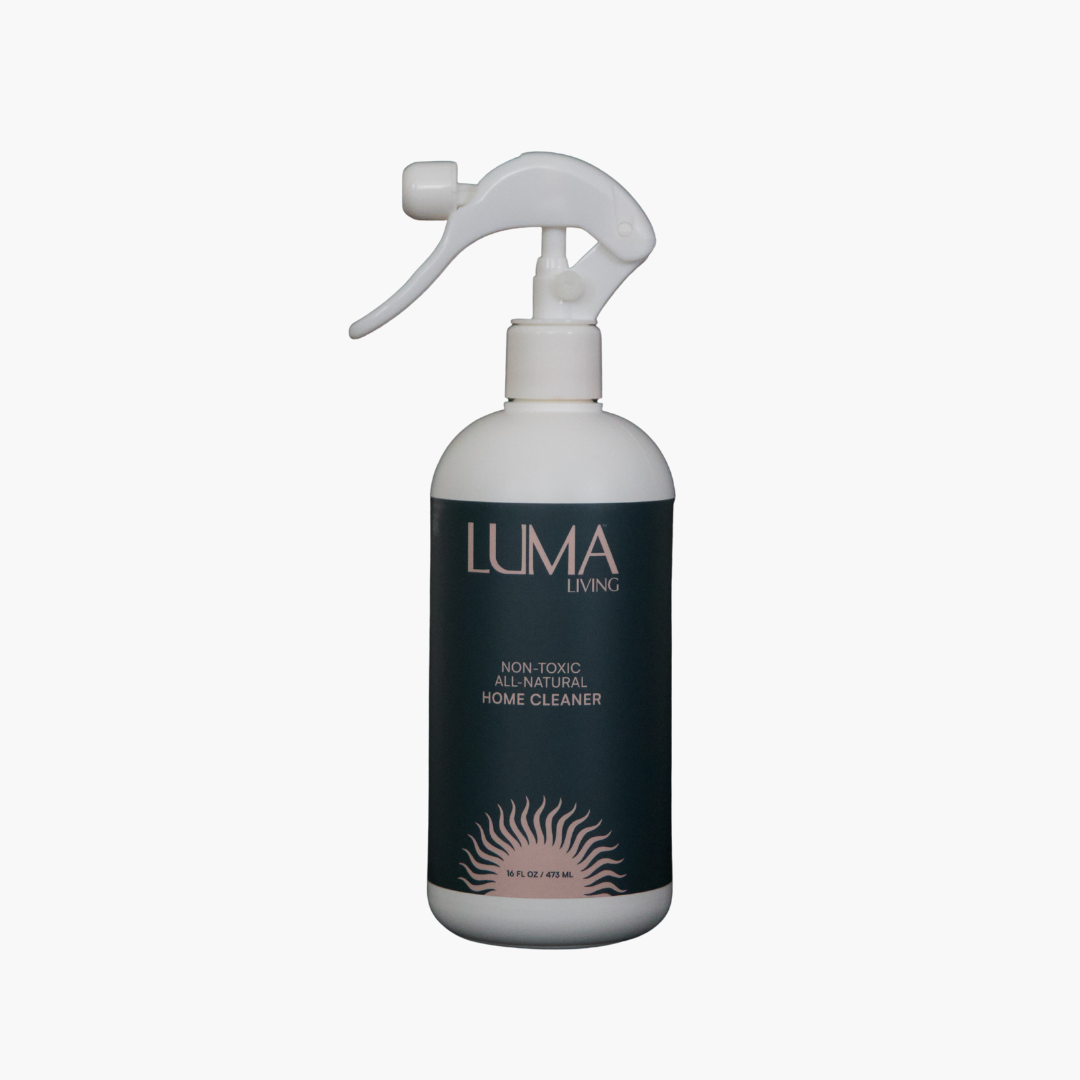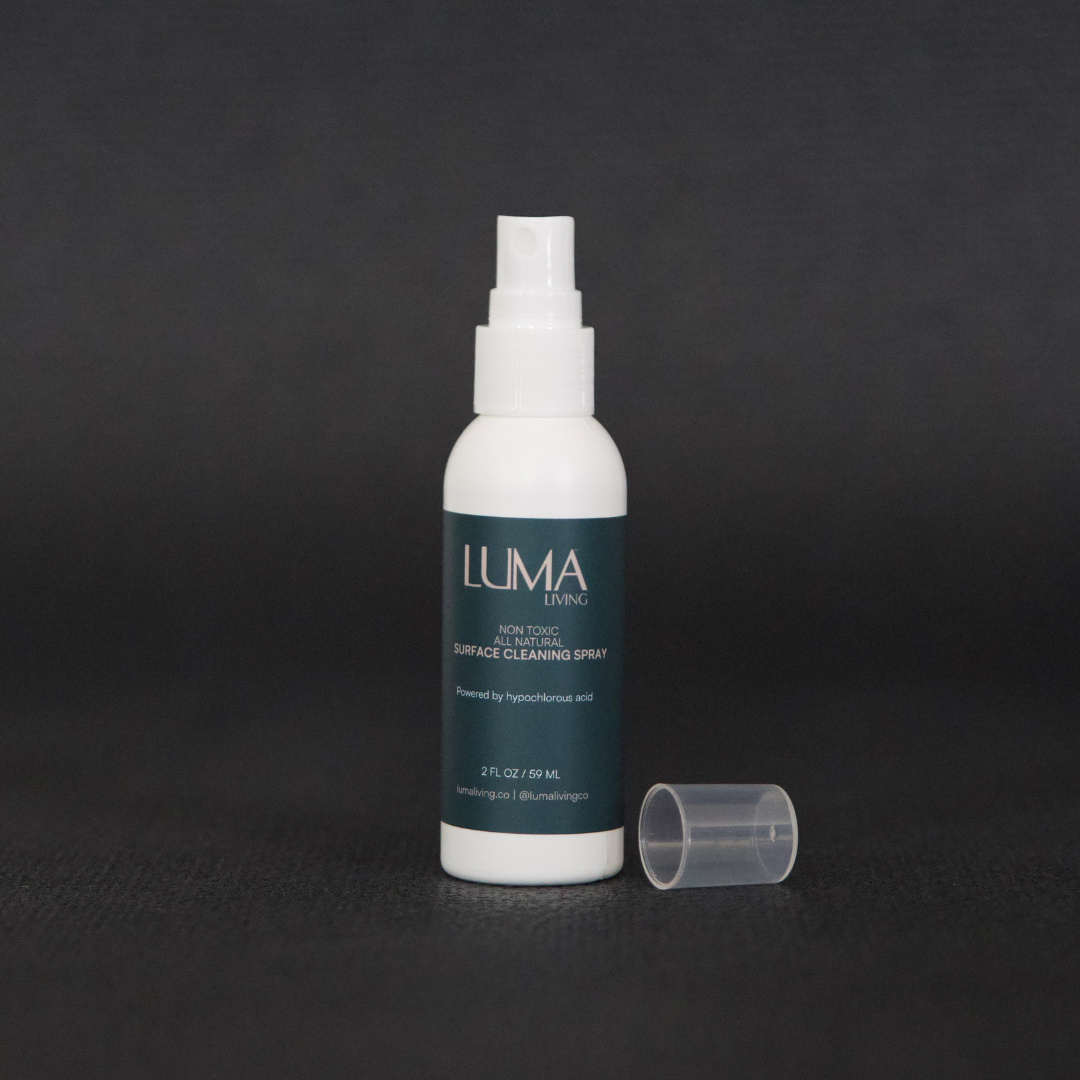A clean kitchen is a calm space, where your family prepares and shares its meals. Choosing a non toxic kitchen cleaner is about keeping that space free from both daily messes and unnecessary chemical residues. This simple approach helps maintain a safe environment for everyone in your home, especially curious children and pets, without harsh films or strong fragrances. Here’s how to clean safely and simply.
Creating a Truly Clean Kitchen Environment

The kitchen is the heart of the home, a place for nourishing our families. Yet, many common cleaning routines rely on harsh chemicals that leave behind strong fumes and lingering residues. This can feel counterintuitive when trying to create a healthy space for the people you care about.
Many of us are looking for a simpler path. One that leads to a calm, safe environment for everyone—toddlers and four-legged friends included. This guide shows how a thoughtful cleaning routine can bring confidence and peace of mind. It demonstrates that effective cleaning does not require aggressive ingredients.
The Shift Toward Safer Cleaning
The growing interest in safer home products reflects a broader movement. The global market for household cleaners made with simpler ingredients, including the non toxic kitchen cleaner category, was valued at around USD 6.56 billion and is expected to grow. This shows a clear shift in what consumers want for their homes: products that support well-being.
Professional kitchens also prioritize cleanliness and safety. A detailed restaurant kitchen cleaning checklist can offer insights into maintaining a spotless space, with principles that can be adapted for home use.
A truly clean kitchen is one that is free from both daily grime and the unnecessary chemicals often used to remove it. This balance creates a space that feels genuinely safe and welcoming for the whole family.
Why a Simple Approach to Cleaning Matters
Choosing a non-toxic kitchen cleaner is about more than what is in the bottle. It supports a home that feels genuinely safe for everyone in it. This decision shifts cleaning from a chore to a deliberate act of care for your family.
From a practical standpoint, many conventional cleaners can create their own problems. Harsh chemicals may leave behind sticky residues on countertops and cutting boards. This means you often end up rinsing and re-wiping, just to remove the cleaner itself. Over time, these same ingredients can wear down the materials in your kitchen.
Strong, artificial fragrances can also linger in the air long after you are done. This creates an environment that feels more chemical than clean. Children and pets are often more sensitive to what is in the air. A simpler approach helps avoid these issues entirely.
Cultivating a Confident Clean
The emotional benefit of this shift is just as real. When you use a simpler, non-toxic routine, you gain a quiet confidence. It is the assurance that comes from knowing your daily habits contribute to a healthier home. For parents and pet owners, that feeling is significant.
This mindset turns cleaning into a thoughtful practice of home care. The goal is not just to make things look good. It is the peace of mind that comes from a straightforward, residue-free routine.
A clean home is a source of comfort. When you trust your cleaning products, you can focus on what truly matters: nourishing your family and enjoying your time together in a space that feels genuinely safe and cared for.
By prioritizing simplicity, you are choosing a calmer atmosphere. A non toxic kitchen cleaner ensures the heart of your home remains a place of nourishment. You're not just cleaning; you're creating a space centered on well-being.
Rethinking What It Means to Be Clean
For a long time, we have been taught to associate "clean" with specific sensory cues. These include bubbling foam, the sharp smell of bleach, or a slick, shiny surface. This leads many people to believe that the more aggressive a cleaner seems, the better it works.
However, those cues are often just marketing. A strong chemical scent is usually an added fragrance designed to signal "clean." This focus on sensory cues often overlooks the downsides of harsh cleaning agents.
The Problem with Harsh Alternatives
Traditional cleaners, like those based on bleach or ammonia, often come with trade-offs. They can require open windows for ventilation and careful handling to avoid irritation. Over time, these powerful chemicals can be harsh on the very surfaces you are trying to protect.
The larger issue for many is the invisible residue they leave behind. After you wipe down a countertop, a thin film can remain. This is not ideal in a space where you prepare food for your family. You can learn more about finding gentle alternatives in our guide to natural alternatives to bleach.
A truly clean kitchen is one that’s free from both grime and the aggressive chemicals used to remove it. It's a space defined not by what’s been added, but by what’s absent—no dirt, no streaks, and no unwanted residues.
A Shift Toward Simpler Solutions
This realization is inspiring a shift in how we care for our homes. More people are reaching for a non toxic kitchen cleaner because they want effectiveness without compromises. It is about making an informed choice for your home, not one based on old habits.
The numbers tell a similar story. In North America alone, the market for household cleaners with simple formulas was valued at USD 2.02 billion and is expected to hit USD 5.45 billion by 2033. This reflects a collective move toward products that align with a healthier home environment. You can see more details on this expanding market at Straits Research.
Ultimately, rethinking cleanliness means moving away from a "more is more" mindset. A true clean does not need to announce itself with overpowering scents or harsh ingredients. It can be quiet, simple, and complete, leaving a calm, cared-for space.
Understanding the Gentle Science of a Better Cleaner
To find a better way to clean, we can look at how nature already handles it. Some of the most effective solutions are inspired by processes happening inside our own bodies.
This is true for a molecule called Hypochlorous Acid (HOCl). The name may sound complex, but the science behind it is simple and gentle. When your immune system senses a threat, it creates HOCl as one of its first responses. It is a part of your body's system, designed to restore balance without harming healthy cells.
A non toxic kitchen cleaner built on this science works in a similar way. It is created using a simple process with just three ingredients: water, salt, and electricity. This reaction produces a powerful cleaning solution that is free from harsh chemicals, added fragrances, or irritating fumes.
Simple Composition for a Safer Home
The real benefit lies in its simplicity. Because it is made from such basic components, it cleans deeply without leaving behind sticky residues. Once its job is done, the solution simply breaks back down into saline water. Nothing is left behind but a truly clean surface.
This makes it a sound choice for all the surfaces your family touches most. You can confidently clean countertops where you prepare food, a high chair, or even a pet's water bowl. For a deeper dive, our guide on the science of Hypochlorous Acid explains it all.
A truly effective cleaner doesn't need to be aggressive. It can be gentle, intelligent, and work in harmony with our desire for a safe home environment, offering peace of mind with every spray.
Beyond the Bottle: A Holistic View of Cleanliness
Creating a truly clean space goes beyond just what is in the spray bottle. It starts with the basics, like ensuring the water in your home is as pure as possible. This can involve things like removing PFAS, microplastics, and fluoride from your water. A clean home is built with clean ingredients.
This infographic helps show the simpler reality of household cleaning.

The image illustrates the shift away from a reliance on harsh chemicals. It points toward embracing gentle, effective alternatives for a truly clean and safe home. This modern approach is about smart science that supports your family’s well-being. It's the foundation of a non toxic kitchen cleaner you can feel good about using every day.
Simple Steps for Your Non-Toxic Kitchen

Bringing a non-toxic kitchen cleaner into your daily routine should feel simple. The goal is to declutter not just your cleaning cabinet, but your mind as well. When you switch to one versatile, science-backed cleaner, maintaining a safe kitchen becomes second nature.
The process is designed to be effortless. For most daily cleaning, simply spray the surface and wipe with a soft cloth. That is all it takes for the spaces you use most often.
Everyday Cleaning Made Simple
This gentle but effective process works well all over your kitchen. It is perfect for the daily upkeep of surfaces that your family and food touch constantly.
- Countertops and Islands: Lightly spray your stone, laminate, or sealed wood counters to wipe away crumbs and spills. It leaves nothing behind.
- High Chairs and Trays: After mealtime, a quick spray-and-wipe cleans up messes, leaving a clean surface for the next meal.
- Cutting Boards: Clean your non-porous cutting boards after preparing meals to keep your food prep space fresh.
This straightforward approach helps you create a consistently clean environment.
Addressing More Demanding Messes
Even the tidiest kitchens have tougher challenges, like greasy stovetops or sticky spills. A non-toxic kitchen cleaner handles these moments with a small change in your technique. Instead of wiping right away, allow the cleaner a moment to work.
For stubborn grime, spray the area generously and let it sit for a minute or two. This pause gives the solution time to break down the buildup, so you can wipe it away with minimal effort. No harsh scrubbing is needed.
This patient approach lets gentle science do the heavy lifting for you. It reflects a larger movement toward simpler, safer products. The global market for kitchen cleaning products is significant, and the growing demand for non-toxic options is a key part of that. This simplified routine provides a powerful clean with minimal effort, bringing peace of mind to your home.
Finding Confidence in Your Clean Home
Choosing a non-toxic kitchen cleaner is about creating a space where you can relax. It is a shift away from a cycle of harsh chemicals and toward a lasting sense of well-being. Real confidence comes from knowing the surfaces your children and pets touch are simply clean, without any lingering films.
This approach helps build a calm, welcoming environment without compromise. It is the peace of mind that comes when your cleaning routine aligns with your desire for a safe home. You can trust that every wipe-down supports your family’s well-being, leaving nothing behind but a fresh, cared-for space.
A truly clean home is one where safety and effectiveness are in balance. It is a space where you can relax, knowing your cleaning choices nurture the well-being of everyone who lives there.
Luma Living was built on this belief. We focus on simple, science-backed cleaning to help you achieve a cleaner, calmer home. It is a clear path to caring for your space and the people in it.
A Few Common Questions
It is normal to have questions before bringing a new product into your home. When it comes to a kitchen cleaner, feeling confident in how it works is important. Here are a few things we are often asked.
Is It Strong Enough for Kitchen Grease?
Yes. A good non-toxic cleaner is designed to handle everyday kitchen messes, including grease. The key to greasy or sticky spills is not about scrubbing harder. It is about giving the cleaner a moment to work.
Just spray the surface well and let it sit for a minute or two. That pause gives the solution time to get underneath the grime and break it down. It makes wiping it away easy, without aggressive chemicals.
Can I Use This on All My Kitchen Surfaces?
One of the best things about modern non-toxic cleaners, especially those based on Hypochlorous Acid (HOCl), is their versatility. You can use them on just about any non-porous surface in your kitchen.
That includes common materials like:
- Sealed stone like granite, marble, and quartz
- Stainless steel appliances
- Laminate countertops
- Glass cooktops
- Finished wood cabinets
Because the formula is free of harsh solvents, dyes, or fragrances, it cleans without the risk of damaging surfaces. This simplifies your routine, allowing you to care for your whole kitchen with one bottle.
What Does Residue-Free Actually Mean for My Family?
Residue-free means that once the cleaner has done its job, it leaves nothing behind. Many conventional cleaners leave an invisible chemical film on countertops where you prepare food or on a high-chair tray.
Cleaners like HOCl are different. They revert to simple saline water and dissipate completely, leaving your surfaces truly clean—not coated. It’s a peace of mind you can feel, knowing there are no unwanted chemicals lingering in your home.
This simple fact ensures the heart of your home remains a place of nourishment and calm. The absence of residue is what creates a genuinely clean environment for the people you care about most.
At Luma Living, we believe a clean home should not come at the cost of your peace of mind. Our approach is rooted in simple, science-backed solutions that are safe for the whole family. Learn more at Luma Living.


